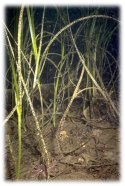Eelgrass
(Zostera marina)

Perhaps you have seen this grass growing underwater in a bay, or seen it floating on the surface of the water after a big storm? Eelgrass is not a "seaweed" because it is not an alga, but rather a plant. It is "submerged aquatic vegetation", or SAV, a plant that lives underwater. It is an angiosperm, which means it produces flowers. Eelgrass beds are very important because they form a distinct ecological niche. They spread via rhizomes, which are modified stems that run sideways instead of vertically. These along with roots not only hold the eelgrass in the sediment, but also hold the sediment in place, preventing erosion. The blades of eelgrass are favorite settling places for epibionts (living things that live on the surface of something) because the grass slows down water flow and is thus more hospitable to planktonic larvae looking for a place to land. Diatoms in particular like eelgrass blade surfaces, forming a fuzzy brown carpet that fosters the settling of other organisms. Anemones and hydroids live on the surface of the blades, snails feed on the surface and lay their eggs on the blade tips, and juvenile fish find shelter in the eelgrass bed. Eelgrass beds also tend to be richer in nutrients than the surrounding water, and acts as a transfer mechanism of nutrients from the water column into the sediment and creatures feeding in the bed. Since it is a plant, it is a primary producer and photosynthesizes. Even when it dies and decomposes, the eelgrass is providing food and shelter. Unfortunately (there always seems to be one of those, doesn't there?) eelgrass beds are being depleted from, you guessed it, human activities such as dredging and large influxes of nutrients. Eelgrass is light-limited, but macroalgae and phytoplankton are nutrient-limited. When there are too many nutrients, macroalgae can overgrow and shade the eelgrass. One more bit of trivia for you linguists and etymologists: the Latin genus name comes from the Greek word for "belt", since the blades are rather belt-like in form.
Take me back to Species of the Week!
Take me back to the Main
Page!